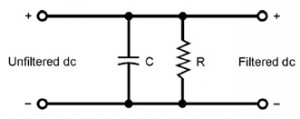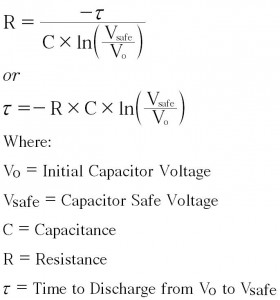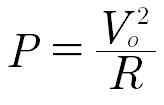Bleeder Resistor Bleeder Resistors are used as a safety feature to discharge capacitors to safe voltage levels after power is removed.  A bleed resistor may be either connected permanently for cost effectiveness and high reliability or switched across a capacitor for rapid discharge without stagnant dissipation. This is used to help improve voltage regulation and is generally used in unregulated direct current (DC) power supplies. The bleeder resistor should have a resistance value high enough so that it does not interfere with the operation of the power supply, but low enough so it will discharge the capacitor in a short time after the power supply has been shut down. There is always a tradeoff between the time to reach a safe discharge and the inert power loss during normal operation. They are connected across the filter capacitors to drain their stored charge and avoid injuring or shocking the user.
A bleed resistor may be either connected permanently for cost effectiveness and high reliability or switched across a capacitor for rapid discharge without stagnant dissipation. This is used to help improve voltage regulation and is generally used in unregulated direct current (DC) power supplies. The bleeder resistor should have a resistance value high enough so that it does not interfere with the operation of the power supply, but low enough so it will discharge the capacitor in a short time after the power supply has been shut down. There is always a tradeoff between the time to reach a safe discharge and the inert power loss during normal operation. They are connected across the filter capacitors to drain their stored charge and avoid injuring or shocking the user.
To calculate the amount of time for a resistor to discharge a capacitor to a safe voltage, use the following calculations: 
Once the resistance value is found, use Ohm’s law to calculate the power rating the resistor needs to be to operate at the peak voltage. 
